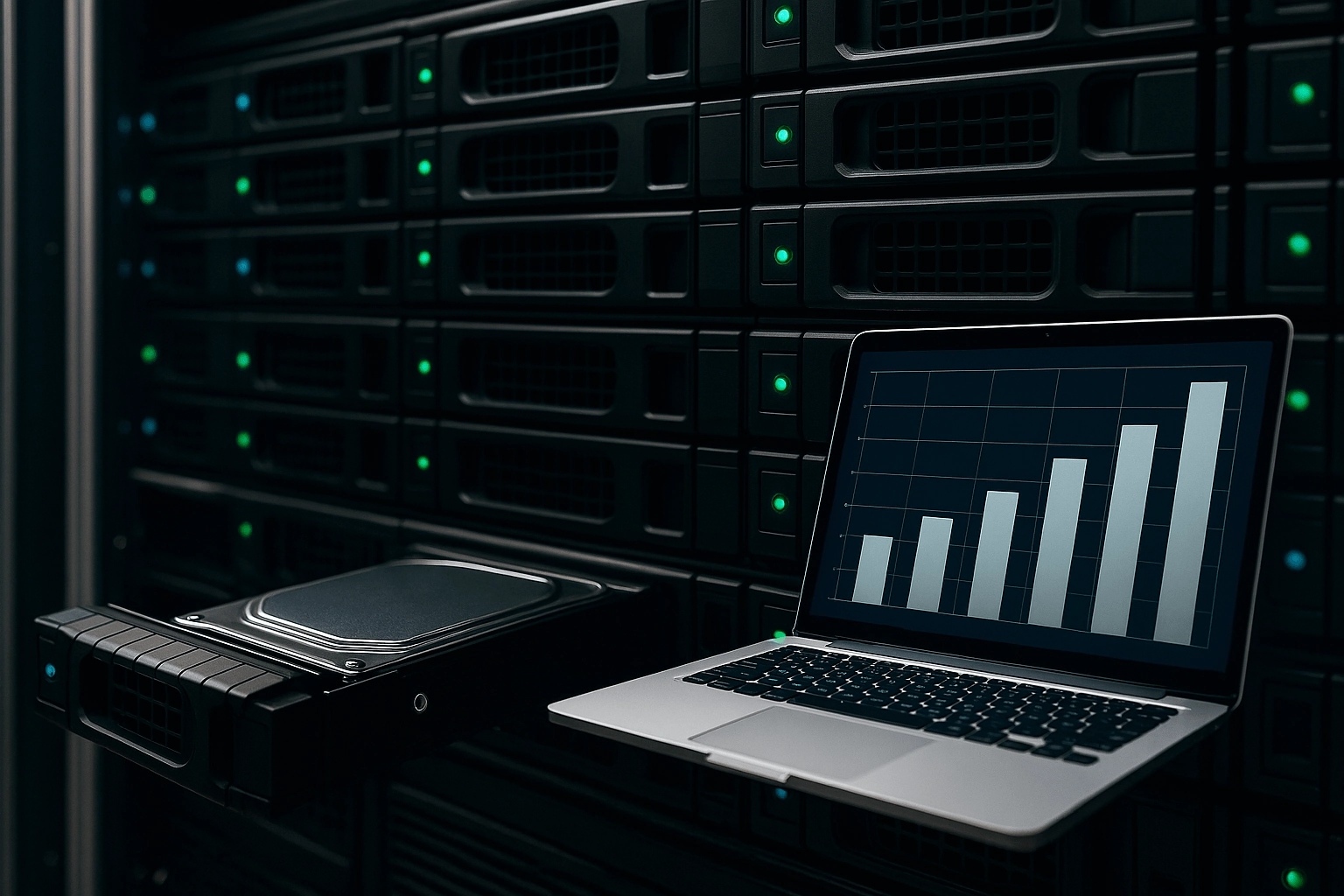When choosing the best hard drive for a server, it’s critical to look beyond just brand reputation and storage capacity. Key factors like yearly workload (TBW/year), Mean Time Between Failures (MTBF), power consumption (idle and under load), and acoustic output (idle/seek noise) all play a role in selecting the right drive for long-term reliability and efficiency.
Whether you’re building a Proxmox server, a NAS for your homelab, or deploying a professional-grade storage solution, the demands on hard drives vary greatly. NAS environments often involve continuous read/write operations and high uptime expectations, while virtualized workloads on Proxmox may stress drives differently – particularly in mixed VM and container setups. For these reasons, it’s important to match the drive’s specifications to your actual usage scenario.
Avoid Consumer HDDs for Server Use
While drives like WD Green, WD Blue, and Seagate Barracuda may seem attractive due to price or availability, they are not designed for 24/7 operation or sustained workloads. These consumer drives typically have lower MTBF ratings, reduced write endurance, and lack vibration protection. Most importantly, they do not support RAID-optimized error recovery (such as TLER or ERC), which is critical in hardware RAID systems. Without these settings, a drive may take too long to recover from a read error and be dropped from the array. ZFS-based systems handle error recovery differently and are more tolerant of such delays, but using enterprise or NAS-grade drives is still recommended for reliability, consistency, and long-term performance.
For any serious server or NAS deployment, especially where uptime and data integrity matter, enterprise or NAS-grade drives offer real advantages. They are built for continuous operation, with firmware tuned for server workloads and features that ensure better thermal control, vibration resistance, and predictable behavior under load.
SATA Drives Only
This comparison focuses exclusively on SATA-based hard drives, as they remain the most common standard for cost-effective, high-capacity server storage. SAS drives are typically reserved for datacenter-grade SANs and specialized enterprise applications.
Complete Technical Comparison
I manually reviewed official datasheets from all major HDD manufacturers – WD, Seagate, and Toshiba, to compile accurate data on reliability, acoustics, and power usage. While exact values can vary slightly depending on capacity (e.g., 14TB vs 24TB models), the numbers listed below are representative of the most common SKUs used in NAS and server environments.
You can sort the table by workload, noise, power draw, or any other metric depending on your use case. By default, the list is sorted from best to worst overall, prioritizing reliability, noise, and power consumption for typical NAS and server workloads.
Note: The listed noise and power figures are average estimates based on real-world usage and may vary slightly by capacity and model. These metrics are useful when planning for energy efficiency and acoustic behavior in both NAS and server environments. Most drives consume between 0.4–1.2 W in standby, which is relevant for setups that spin down idle disks to save power and reduce heat.
| Drive | Class | TBW/y | MTBF/h | RPM | Helium | dBA Idle | dBA Seek | W Idle | W Load |
|---|---|---|---|---|---|---|---|---|---|
| WD Gold | Data Center | 550 TB | 2.5M | 7200 | Yes | ~20 dBA | 32-36 dBA | ~5.6 W | ~6.5 W |
| WD Ultrastar DC | Data Center | 550 TB | 2.5M | 7200 | Yes | ~20 dBA | 36 dBA | ~5.6 W | ~6.5 W |
| Toshiba MG | Data Center | 550 TB | 2.5M | 7200 | Yes | ~28-30 dBA | ~32-36 dBA | ~4.5 W | ~8.5 W |
| Seagate Exos X | Data Center | 550 TB | 2.5M | 7200 | Yes | ~28-30 dBA | ~32-36 dBA | ~6.3 W | ~7.1 W |
| Seagate Exos M | Data Center | 550 TB | 2.5M | 7200 | Yes | ~28-30 dBA | ~32-36 dBA | ~6.9 W | ~9.5 W |
| WD Red Pro | Prosumer | 550 TB | 2.5M | 7200 | Yes | ~20 dBA | ~32-36 dBA | ~3.8 W | ~6.1 W |
| Seagate IronWolf Pro | Prosumer | 550 TB | 2.5M | 7200 | Yes | ~27 dBA | ~32-34 dBA | ~5.0 W | ~7.6 W |
| Toshiba N300 | Consumer | 180 TB | 1.2M | 7200 | Yes | ~20 dBA | ~28-30 dBA | ~4.1 W | ~7.4 W |
| Seagate IronWolf | Consumer | 180 TB | 1.0M | 7200 | Yes | ~28 dBA | ~30 dBA | ~5.1 W | ~7.3 W |
| WD Red Plus | Consumer | 180 TB | 1.0M | 5400 | No | ~20-34 dBA | ~26-39 dBA | ~6.1 W | ~8.8 W |
| WD Red | Consumer | 180 TB | 1.0M | 5400 | No | ~23 dBA | ~27 dBA | ~3.1 W | ~4.8 W |
Prison Comparison
To help you find the best deal, here are a few reputable sites that track current hard drive prices across vendors. These can be useful when balancing performance with budget:
- EU
- 🇩🇪 geizhals.eu – European price comparison with filters for noise, power draw, and more
- 🇩🇪 idealo.de – German comparison site with good coverage of enterprise drives
- 🇩🇰 pricerunner.dk – Denmark’s largest price‑comparison service, offering price histories and alerts
- 🇩🇰 pc-lager.dk – Danish retailer that often lists refurbished hard drives and server parts at competitive prices
- 🇵🇱 ceneo.pl – Poland’s most popular comparison platform with price history tracking
- US
- 🇺🇸 pcpartpicker.com – Great for U.S. prices and compatibility tracking
- 🇺🇸 serverpartdeals.com – U.S.-based seller focused on refurbished and new server hardware at discount prices
- 🇺🇸 seagate.com – Seagate’s official store occasionally runs exclusive discounts and clearance deals
- 🇺🇸 westerndigital.com – WD’s own site sometimes offers discounts not found elsewhere
